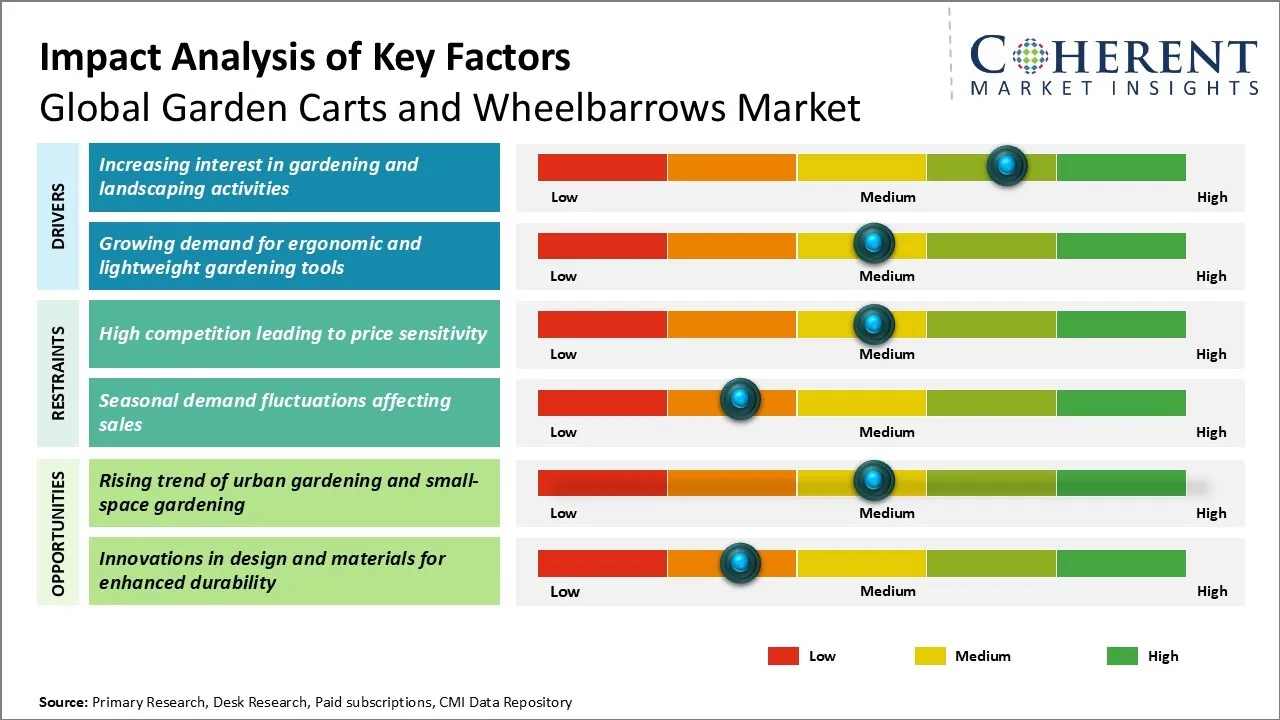The global garden carts and wheelbarrows market is estimated to be valued at USD 2.84 Bn in 2025 and is expected to reach USD 4.69 Bn by 2032, exhibiting a compound annual growth rate (CAGR) of 7.4% from 2025 to 2032.
Key Takeaways of the Garden Carts and Wheelbarrows Market:
Market Overview:
The global garden carts and wheelbarrows market is witnessing positive trends. There is an increasing demand for garden carts and wheelbarrows that are lightweight, durable, and easy to maneuver. Manufacturers are focusing on launching innovative products integrated with new features such as pneumatic tires, protective side rails, large Dumpbins for improved holding capacity, and easy steering for better handling on uneven terrains. They are using superior quality materials, such as powder-coated steel and rust resistant aluminum, to make products weather resistant and prolong product life. In addition, proliferation of online sales channels for garden products coupled with growing DIY culture is expected to drive the sales of garden carts and wheelbarrows globally during the forecast period.
Material Type Insights - The Durability and Strength of Steel Garden Carts and Wheelbarrows
In terms of material type, the steel segment is expected to contribute 31.5% share of the market in 2025, owing to its sturdiness and durability. Steel garden carts and wheelbarrows are able to withstand heavy loads and rigorous use compared to other materials. Their solid steel construction allows them to last for several years of heavy gardening work without breaking or showing signs of damage. This sturdiness is a top priority for most serious gardeners and landscapers who rely on these products on a daily basis. The strength of steel helps ensure carts and wheelbarrows can be loaded heavily with pots, tools, compost, or other materials without failure or accidents.
Wheel Type Insights - The Advantage of Single-Wheel Garden Carts and Wheelbarrows
In terms of wheel type, the one wheel segment is expected to contribute 30.5% share of the market in 2025, as it provides maximum maneuverability. For gardeners and landscapers, being able to easily navigate various garden areas, slopes, and cramped spaces is paramount. The compact design of a single wheel allows for unparalleled agility compared to multi-wheel options. Users can easily guide one-wheeled carts and wheelbarrows along winding paths, around plants, furniture, and other obstacles. This level of maneuverability streamlines workflow and prevents injuries that could occur from losing control of bulkier carts.
Capacity Insights - Balancing Load Capacity and Portability in Garden Carts and Wheelbarrows
In terms of capacity, the up to 100 lbs. segment is expected to contribute 28.7% share of the market in 2025, as it strikes the right balance of portability and load capacity for most light gardening and landscaping jobs. While carrying very heavy loads, 200+ lbs. options provide the greatest tolerance. However, their bulky sizes can be difficult to steer and require significant upper body strength to push or pull over varied terrain. Loads under 100 lbs. maintain a compact profile that makes the carts and wheelbarrows highly portable and less tiring to use. Further, occasional gardeners or households with smaller yards tend not to need to transport massive volumes of materials on a regular basis.

Need a Different Region or Segment? Download Free Sample
North America Garden Carts and Wheelbarrows Market Trends
The North America region is expected to dominate the garden carts and wheelbarrows market, accounting for a 37.6% share by the end of 2025. This leadership is largely driven by the well-established landscaping and gardening culture in countries like the U.S. With a high rate of home and backyard ownership, there is a strong demand for garden equipment to support lawn and yard maintenance. Additionally, leading companies such as Garden Way Inc have built reputable brands and extensive distribution networks, further reinforcing North America's market presence.
Asia Pacific Garden Carts and Wheelbarrows Market Trends
The Asia Pacific region is expected to account for 24.5% of the garden carts and wheelbarrows market share in 2025, making it the fastest-growing market. This growth is primarily driven by countries like China, India, and other Southeast Asian nations. Increasing affluence, rapid urbanization, and exposure to Western gardening trends are encouraging a rise in do-it-yourself lawn and garden activities. Additionally, government initiatives supporting urban greening and sustainable landscaping are further boosting market expansion. Leading regional players, such as Qingdao Taifa Group, have capitalized on this trend by offering innovative, cost-effective, and locally-tailored products.
Garden Carts and Wheelbarrows Market Outlook for Key Countries
U.S. Garden Carts and Wheelbarrows Market Trends
The U.S. market for garden carts and wheelbarrows is experiencing robust growth, driven by the increasing popularity of gardening and landscaping activities among homeowners. The market expanded significantly as consumers invested in outdoor living spaces. A significant contributor to this expansion is Ames True Temper, a leading manufacturer of non-powered lawn and garden products which produces approximately 85% of the wheelbarrows used in the U.S. and Canada, amounting to 1.7 million units annually.
Germany Garden Carts and Wheelbarrows Market Trends
Germany's garden carts and wheelbarrows market saw significant growth, propelled by a strong gardening culture and a heightened focus on sustainability. This surge in demand for eco-friendly gardening tools aligns with the German government's initiatives to promote urban gardening. One notable example is the "Edible City Network" (EdiCitNet) project in Berlin, which has transformed former urban spaces into community gardens. These gardens not only enhance biodiversity but also serve as social hubs, offering training and fostering community engagement. Such initiatives have been instrumental in boosting the market for sustainable gardening tools in Germany.
China Garden Carts and Wheelbarrows Market Trends
China's garden carts and wheelbarrows market experienced rapid expansion, fueled by urbanization, rising disposable incomes, and a growing interest in home gardening and landscaping. A significant contributor to this market growth is Qingdao Taifa Group Co., Ltd., one of China's leading manufacturers of wheelbarrows and garden carts. the company has played a pivotal role in meeting the increasing demand for high-quality gardening tools. Their extensive product range and commitment to quality have positioned them as a key player in the industry, supporting the nation's emphasis on enhancing urban green spaces.
Canada Garden Carts and Wheelbarrows Market Trends
The Canadian garden carts and wheelbarrows market experienced growth, driven by increased interest in gardening and outdoor activities among Canadians. This trend was further amplified by a surge in home improvement projects and a growing preference for sustainable gardening practices. A notable contributor to this market expansion is Greenworks Tools Canada Inc., a company dedicated to producing eco-friendly, battery-powered outdoor equipment. Their range of 60V electric wheelbarrows offers Canadian consumers efficient and environmentally friendly alternatives to traditional gas-powered tools, aligning with the country's shift towards sustainable gardening solutions.
Australia Garden Carts and Wheelbarrows Market Trends
Australia's garden carts and wheelbarrows market experienced significant growth, driven by the increasing popularity of gardening as a leisure activity and substantial investments by Australians in their outdoor spaces. This expansion is further supported by government initiatives promoting sustainable gardening practices. A notable example is the "Gardening Responsibly" initiative launched in New South Wales, which aims to reduce the number of ornamental plants that become invasive weeds by encouraging the use of low-risk plants. A key player contributing to this market growth is Eco-Green Garden Care, Australia's only carbon-neutral gardening service provider. In March 2021, they received carbon-neutral certification under the Commonwealth Government's Climate Active initiative, offering environmentally conscious consumers sustainable gardening solutions.

Get actionable strategies to beat competition: Download Free Sample
Key Developments:
Top Strategies Followed by Global Garden Carts and Wheelbarrows Market Players
Emerging Startups - Garden Carts and Wheelbarrows Industry Ecosystem
Garden Carts and Wheelbarrows Market Report Coverage
| Report Coverage | Details | ||
|---|---|---|---|
| Base Year: | 2024 | Market Size in 2025: | US$ 2.84 Bn |
| Historical Data for: | 2020 To 2024 | Forecast Period: | 2025 To 2032 |
| Forecast Period 2025 to 2032 CAGR: | 7.4% | 2032 Value Projection: | US$ 4.69 Bn |
| Geographies covered: |
|
||
| Segments covered: |
|
||
| Companies covered: |
The AMES Companies, Inc., Garden Way Inc., Rubbermaid Commercial Products LLC, Truper Herramientas, Suncast Corporation, Gorilla Carts, Troy-Bilt LLC, Lifetime Products, Inc., Jackson Professional Tools, Radius Garden, Craftsman, Big Red, DuraCart, Steel Hand, and Emsco Group |
||
| Growth Drivers: |
|
||
| Restraints & Challenges: |
|
||
Uncover macros and micros vetted on 75+ parameters: Get instant access to report

Discover market dynamics shaping the industry: Download Free Sample
Garden Carts and Wheelbarrows Market Growth Factors
Increasing interest in gardening and landscaping activities
As the world emerges from the shadows of the pandemic, various lifestyle changes have become quite prominent. Being confined indoors for extended periods made people appreciate the comforts of outdoor spaces much more. This paved the way for increasing interest in activities like gardening and landscaping. Gardening in particular saw a major boost as more people took interest in growing their own organic foods as well as bringing greenery around their living spaces. Having plants and flowers lit up mental wellbeing in testing times while homegrown produce helped supplemented nutrition.
Market Challenge - High competition leading to price sensitivity
The global garden carts and wheelbarrows market is facing high competition leading to price sensitivity. With the presence of numerous established as well as new players, the market is highly fragmented. Players are focusing on product differentiation and constant innovation to gain competitive advantage. However, high competition has negatively impacted the pricing scenario. Players are compelled to maintain competitive pricing to survive in the market. This has significantly reduced the profit margins for players. Additionally, the growing bargaining power of retailers have further intensified the pricing pressure. Retailers demand competitive pricing from vendors to gain higher margins. Players find it difficult to pass on the rising costs to customers due to sensitivities around pricing. This challenge of high competition and price sensitivity can threaten the profitability of players in the short to medium term if not addressed strategically.
Market Opportunity - Rising trend of urban gardening and small-space gardening
The global garden carts and wheelbarrows market is witnessing new opportunities due to the rising trend of urban gardening and small-space gardening. With increasing urbanization, there is growing preference for gardening even within limited space availability in urban settings. This has driven the demand for garden tools and equipment suitable for small gardens and terraces in homes and apartments. Garden carts and wheelbarrows specially designed for compact use are gaining traction in this space. Their maneuverability and folding designs help tackle the issue of limited storage availability. Players can capitalize on this opportunity by developing a range of innovative and specialized products catering to the needs of small-space urban gardening. Targeting e-commerce platforms can help reach a wider audience and boost sales.
Share
Share
About Author
Ramprasad Bhute is a Senior Research Consultant with over 6 years of experience in market research and business consulting. He manages consulting and market research projects centered on go-to-market strategy, opportunity analysis, competitive landscape, and market size estimation and forecasting. He also advises clients on identifying and targeting absolute opportunities to penetrate untapped markets.
Missing comfort of reading report in your local language? Find your preferred language :
Transform your Strategy with Exclusive Trending Reports :
Frequently Asked Questions
Joining thousands of companies around the world committed to making the Excellent Business Solutions.
View All Our Clients